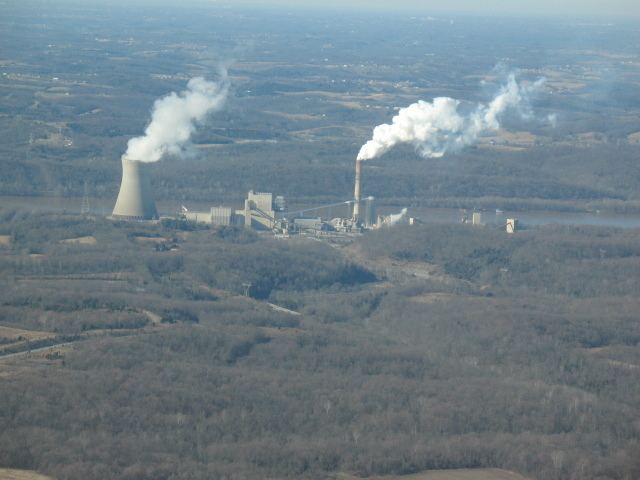Country United States Commission date 1991 Phone +1 513-553-2021 | Status In operation | |
 | ||
Owner(s) Dayton Power and Light, Inc.Dynergy, Inc. Address Cinergy Access Rd, Moscow, OH 45153, USA | ||
The William H. Zimmer Power Station, located near Moscow, Ohio, is a coal-fired power plant owned by Dynegy, Inc. It was originally intended to be a boiling water reactor type of nuclear power plant. Although once estimated to be 97% complete, poor construction and quality assurance (QA) led to the plant being converted to coal-fired generation. As of 2012, the plant generates 1460 gross MWe and 1300 net MWe. Zimmer Power Station is the largest single-unit power facility in the United States. During the construction of the plant, the Little Indian Creek was routed through the plant to protect fish populations. The plant now has several unique environmental protection features to keep the creek at its natural state.
Contents
HistoryEdit
As a result of two separate probes into defective pipe welds, the Nuclear Regulatory Commission fined Cincinnati Gas and Electric $200,000 for a faulty quality assurance program. The NRC, under pressure, eventually ordered work on the nuclear reactor to halt in 1982.
Cincinnati Gas and Electric, with two other electric utilities (American Electric Power and Dayton Power and Light), announced the cancellation of the Zimmer nuclear power plant in October 1983. Zimmer's total sunk costs equaled some $1.8 billion; Cincinnati's share amounted to $716 million, which was almost 90 percent of the utility's 1982 net worth.
Originally expected to cost $230 million, when the cost estimate soared to at least $3.4 billion the decision was made in 1984 to convert the plant. (Regulatory delays and high interest rates also contributed to the cost increase.)
The constructor, the Henry J. Kaiser Company, had never built a nuclear power plant before (or since). The primary owner, Cincinnati Gas and Electric, did its own procurement, awarding contracts for equipment, e.g., for hundreds of valves, with inadequate specifications or QA requirements. Piping welds were not adequately radiographed.
Sargent & Lundy was the Architect/Engineering firm.
An ex-Navy admiral was hired to bring the plant on-line, and Bechtel was retained to nuclear-qualify the plant. Bechtel came in with an estimate of more than $1.5 billion—beyond the $1.7 billion already spent—to adequately complete the plant.
Converting the mothballed plant to coal-fired generation started in 1987. After $1 billion in expenditures, the world's first nuclear-to-coal power plant was completed in 1991.
The plant was named for William H. Zimmer, who was chairman and president of Cincinnati Gas & Electric Co. from 1962 to 1975.
EquipmentEdit
The plant utilizes equipment from the old nuclear plant in conjunction with the coal conversion equipment. The original Westinghouse Electric Company high-pressure/low-pressure turbine was modified and the high-pressure section was removed. The Westinghouse generator was to generate 838 MWe per the original nuclear design. Asea Brown Boveri was contracted to design the high-pressure turbine, intermediate-pressure/reheat turbine and generator. The HP/IP generator produces 900 MWe and the Westinghouse LP generator produces 497 MWe. The plant's feedwater pump is powered by a turbine, rather than electrical pumps like in many other plants. The feedwater turbine was designed by Asea Brown Boveri and generates 50,000 kW (67,000 hp).
The boiler was designed by Babcock & Wilcox. It is a supercritical boiler with a maximum superheater outlet pressure of about 3800 psi and temperature of about 1050 degrees Fahrenheit. The reheat section of the boiler operates at about 650 psi (4,500 kPa) and 566 °C (1,050 °F).
The plant also uses several environmental controls such as selective catalytic reduction to reduce NOx emissions, electrostatic precipitators to remove fly ash, and a recently upgraded flue-gas desulfurization system which now removes up to 98% of the sulfur dioxide. The gypsum byproduct of the FGD system is sold to make drywall and fertilizer. Many new environmental controls are also tested at this plant.
The plant's hyperboloid cooling tower was designed to handle the cooling for the original nuclear plant. This creates generating efficiency issues during very hot summer days, as the cooling tower must cool much more equipment than it was originally designed for.
